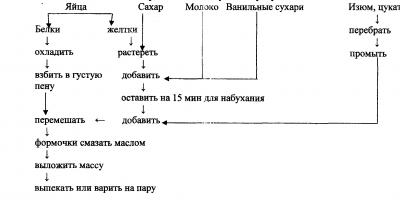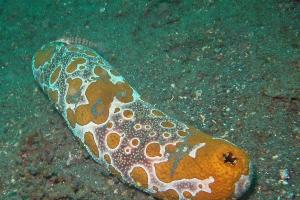Mendel's first law. Law of Uniformity of First Generation Hybrids
When crossing homozygous individuals that differ in one pair of alternative (mutually exclusive) characters, all offspring in first generation uniform in both phenotype and genotype.
Pea plants with yellow (dominant trait) and green (recessive trait) seeds were crossed. The formation of gametes is accompanied by meiosis. Each plant produces one type of gamete. From each homologous pair of chromosomes, one chromosome with one of the allelic genes (A or a) goes into gametes. After fertilization, the pairing of homologous chromosomes is restored and hybrids are formed. All plants will have only yellow seeds (phenotype), heterozygous for the Aa genotype. This happens when complete dominance.
Hybrid Aa has one gene A from one parent, and the second gene - a - from the other parent (Fig. 73).
Haploid gametes (G), unlike diploid organisms, are circled.
As a result of crossing, first generation hybrids are obtained, designated F 1.
To record crosses, a special table is used, proposed by the English geneticist Punnett and called the Punnett grid.
The gametes of the paternal individual are written out horizontally, and the gametes of the maternal individual vertically. Genotyping is recorded at intersections.

Rice. 73.Inheritance in monohybrid crosses.
I - crossing two varieties of peas with yellow and green seeds (P); II
Cytological foundations of Mendel's I and II laws.
F 1 - heterozygotes (Aa), F 2 - segregation according to genotype 1 AA: 2 Aa: 1 aa.
py descendants. In the table, the number of cells depends on the number of gamete types produced by the individuals being crossed.
Mendel's II law. The law of splitting of first generation hybrids
When hybrids of the first generation are crossed with each other, individuals with both dominant and recessive traits appear in the second generation and splitting occurs by phenotype in a ratio of 3:1 (three dominant phenotypes and one recessive) and 1:2:1 by genotype (see. Fig. 73). Such splitting is possible when complete dominance.

Hypothesis of “purity” of gametes
The law of splitting can be explained by the hypothesis of the “purity” of gametes.
Mendel called the phenomenon of non-mixing of alleles of alternative characters in the gametes of a heterozygous organism (hybrid) the hypothesis of “purity” of gametes. Two allelic genes (Aa) are responsible for each trait. When hybrids are formed, allelic genes are not mixed, but remain unchanged.
As a result of meiosis, Aa hybrids form two types of gametes. Each gamete contains one of a pair of homologous chromosomes with allelic gene A or allelic gene a. Gametes are pure from another allelic gene. During fertilization, the homology of chromosomes and allelicity of genes are restored, and a recessive trait (the green color of peas) appears, the gene of which did not show its effect in the hybrid organism. Traits develop through the interaction of genes.

Incomplete dominance
At incomplete dominance heterozygous individuals have their own phenotype, and the trait is intermediate.
When crossing night beauty plants with red and white flowers, pink-colored individuals appear in the first generation. When crossing first-generation hybrids (pink flowers), the cleavage in the offspring by genotype and phenotype coincides (Fig. 74).


Rice. 74.Inheritance with incomplete dominance in the night beauty plant.
The gene that causes sickle cell anemia in humans has the property of incomplete dominance.
Analysis cross
The recessive trait (green peas) appears only in the homozygous state. Homozygous (yellow peas) and heterozygous (yellow peas) individuals with dominant traits do not differ from each other in phenotype, but have different genotypes. Their genotypes can be determined by crossing with individuals with a known genotype. Such an individual may be green peas, which have a homozygous recessive trait. This cross is called an analyzed cross. If, as a result of crossing, all the offspring are uniform, then the individual under study is homozygous.
If splitting occurs, then the individual is heterozygous. The offspring of a heterozygous individual produces cleavage in a 1:1 ratio.

Mendel's III law. Law of independent combination of characteristics (Fig. 75). Organisms differ from each other in several ways.
The crossing of individuals that differ in two characteristics is called dihybrid, and in many respects - polyhybrid.
When crossing homozygous individuals that differ in two pairs of alternative characters, in the second generation occurs independent combination of features.
As a result of dihybrid crossing, the entire first generation is uniform. In the second generation, phenotypic cleavage occurs in a ratio of 9:3:3:1.
For example, if you cross a pea with yellow seeds and a smooth surface (dominant trait) with a pea with green seeds and a wrinkled surface (recessive trait), the entire first generation will be uniform (yellow and smooth seeds).


When hybrids were crossed with each other in the second generation, individuals appeared with characteristics that were not present in the original forms (yellow wrinkled and green smooth seeds). These traits are inherited regardless from each other.

A diheterozygous individual produced 4 types of gametes
For the convenience of counting individuals resulting in the second generation after crossing hybrids, the Punnett grid is used.


Rice. 75.Independent distribution of traits in dihybrid crosses. A, B, a, b - dominant and recessive alleles that control the development of two traits. G - germ cells of the parents; F 1 - first generation hybrids; F 2 - second generation hybrids.
As a result of meiosis, one of the allelic genes from a homologous pair of chromosomes will be transferred to each gamete.
4 types of gametes are formed. Cleavage after crossing in the ratio 9:3:3:1 (9 individuals with two dominant traits, 1 individual with two recessive traits, 3 individuals with one dominant and the other recessive traits, 3 individuals with dominant and recessive traits).
The appearance of individuals with dominant and recessive traits is possible because the genes responsible for the color and shape of peas are located on various non-homologous chromosomes.
Each pair of allelic genes is distributed independently of the other pair, and therefore genes can be combined independently.
A heterozygous individual for “n” pairs of characteristics forms 2 n types of gametes.
Questions for self-control
1. How is Mendel’s first law formulated?
2. What seeds did Mendel cross with peas?
3. Plants with what seeds resulted from crossing?
4. How is Mendel’s II law formulated?
5. Plants with what characteristics were obtained as a result of crossing first generation hybrids?
6. In what numerical ratio does splitting occur?
7. How can the law of splitting be explained?
8. How to explain the hypothesis of “purity” of gametes?
9. How to explain the incomplete dominance of traits? 10. What kind of cleavage by phenotype and genotype occurs
after crossing first generation hybrids?
11.When is an analytical cross carried out?
12. How is an analytical cross carried out?
13.What kind of cross is called dihybrid?
14. On which chromosomes are the genes responsible for the color and shape of peas located?
15. How is Mendel’s III law formulated?
16. What phenotypic cleavage occurs in the first generation?
17. What kind of phenotypic cleavage occurs in the second generation?
18.What is used for the convenience of counting individuals resulting from crossing hybrids?
19.How can we explain the appearance of individuals with characteristics that were not there before?
Keywords of the topic “Mendel’s Laws”
allelicity anemia
interaction
gametes
gene
genotype
heterozygote
hybrid
hypothesis of "purity" of gametes
homozygote
homology
peas
pea
action
dihybrid
dominance
uniformity
law
meiosis
education coloring
fertilization
individual
pairing
surface
count
generation
polyhybrid
offspring
appearance
sign
plant
split
Punnett grid
parents
property
seeds
crossing
merger
ratio
variety
convenience
phenotype
form
character
color
flowers
Multiple allelism
Allelic genes may include not two, but a greater number of genes. These are multiple alleles. They arise as a result of mutation (replacement or loss of a nucleotide in a DNA molecule). An example of multiple alleles can be the genes responsible for human blood groups: I A, I B, I 0. Genes I A and I B are dominant to the I 0 gene. Only two genes from a series of alleles are always present in a genotype. Genes I 0 I 0 determine blood group I, genes I A I A, I A I O - group II, I B I B, I B I 0 - group III, I A I B - group IV.
Gene interaction
There is a complex relationship between a gene and a trait. One gene can be responsible for the development of one trait.
Genes are responsible for the synthesis of proteins that catalyze certain biochemical reactions, resulting in certain characteristics.
One gene can be responsible for the development of several traits, exhibiting pleiotropic effect. The severity of the pleiotropic effect of a gene depends on the biochemical reaction catalyzed by the enzyme synthesized under the control of this gene.
Several genes may be responsible for the development of one trait - this is polymer gene action.
The manifestation of symptoms is the result of the interaction of various biochemical reactions. These interactions can be associated with allelic and non-allelic genes.
Interaction of allelic genes.
The interaction of genes located in the same allelic pair occurs as follows:
. complete dominance;
. incomplete dominance;
. co-dominance;
. overdominance.
At complete In dominance, the action of one (dominant) gene completely suppresses the action of another (recessive). When crossing, a dominant trait appears in the first generation (for example, the yellow color of peas).
At incomplete dominance occurs when the effect of a dominant allele is weakened in the presence of a recessive one. Heterozygous individuals obtained as a result of crossing have their own genotype. For example, when crossing night beauty plants with red and white flowers, pink flowers appear.
At co-dominance The effect of both genes is manifested when they are present simultaneously. As a result, a new symptom appears.
For example, blood group IV (I A I B) in humans is formed by the interaction of genes I A and I B. Separately, the I A gene determines the II blood group, and the I B gene determines the III blood group.
At overdominance the dominant allele in the heterozygous state has a stronger manifestation of the trait than in the homozygous state.
Interaction of nonallelic genes
One trait of an organism can often be influenced by several pairs of non-allelic genes.
The interaction of non-allelic genes occurs as follows:
. complementarity;
. epistasis;
. polymers.
Complementary the effect manifests itself with the simultaneous presence of two dominant non-allelic genes in the genotype of organisms. Each of the dominant genes can manifest itself independently if the other is in a recessive state, but their joint presence in a dominant state in the zygote determines a new state of the trait.
Example. Two varieties of sweet peas with white flowers were crossed. All first generation hybrids had red flowers. Flower color depends on two interacting genes A and B.

Proteins (enzymes) synthesized on the basis of genes A and B catalyze biochemical reactions that lead to the manifestation of the trait (red color of flowers).
Epistasis- an interaction in which one of the dominant or recessive non-allelic genes suppresses the action of another non-allelic gene. A gene that suppresses the action of another is called an epistatic gene, or suppressor. The suppressed gene is called hypostatic. Epistasis can be dominant or recessive.
Dominant epistasis. An example of dominant epistasis would be the inheritance of plumage color in chickens. The dominant gene C is responsible for plumage color. The dominant non-allelic gene I suppresses the development of plumage color. As a result of this, chickens that have the C gene in the genotype, in the presence of the I gene, have white plumage: IICC; IICC; IiCc; Iicc. Hens with the iicc genotype will also be white because these genes are in a recessive state. The plumage of chickens with the iiCC, iiCc genotype will be colored. The white color of the plumage is due to the presence of a recessive allele of the i gene or the presence of the color suppressor gene I. The interaction of genes is based on biochemical connections between enzyme proteins, which are encoded by epistatic genes.
Recessive epistasis. Recessive epistasis explains the Bombay phenomenon - the unusual inheritance of antigens of the ABO blood group system. There are 4 known blood groups.
In the family of a woman with blood group I (I 0 I 0), a man with blood group II (I A I A) gave birth to a child with blood group IV (I A I B), which is impossible. It turned out that the woman inherited the I B gene from her mother and the I 0 gene from her father. Only the I 0 gene showed an effect, therefore
it was believed that the woman had blood type I. Gene I B was suppressed by the recessive gene x, which was in a homozygous state - xx.

In the child of this woman, the suppressed I B gene showed its effect. The child had IV blood group I A I B.
PolymerThe effect of genes is due to the fact that several non-allelic genes can be responsible for the same trait, enhancing its manifestation. Traits that depend on polymer genes are classified as quantitative. Genes responsible for the development of quantitative traits have a cumulative effect. For example, polymeric non-allelic genes S 1 and S 2 are responsible for skin pigmentation in humans. In the presence of dominant alleles of these genes, a lot of pigment is synthesized, in the presence of recessive ones - little. The intensity of skin color depends on the amount of pigment, which is determined by the number of dominant genes.

From a marriage between mulattoes S 1 s 1 S 2 s 2, children are born with skin pigmentation from light to dark, but the probability of having a child with white and black skin color is 1/16.
Many traits are inherited according to the polymeric principle.
Questions for self-control
1. What are multiple alleles?
2. What genes are responsible for human blood types?
3. What blood types does a person have?
4. What connections exist between a gene and a trait?
5. How do allelic genes interact?
6. How do non-allelic genes interact?
7. How can the complementary action of a gene be explained?
8. How can epistasis be explained?
9. How can the polymeric action of a gene be explained?
Keywords of the topic “Multiple alleles and gene interaction”
allelism allele antigens marriage
interaction
genotype
hybrid
peas
peas
blood type
action
children
dominance
woman
replacement
codominance
co-dominance
leather
chickens
mother
molecule
mulatto
mutation
Availability
inheritance
nucleotides
coloring
plumage
the basis
attitude
pigment
pigmentation
pleiotropy
suppressor
generation
polymerism
sign
example
presence
manifestation
development
reactions
child
result
overdominance connection
protein synthesis system
crossing
state
degree
loss
phenomenon
enzymes
color
flowers
Human
Monohybrid crossing. Mendel's first law.
In Mendel's experiments, when crossing pea varieties that had yellow and green seeds, all the offspring (i.e., first generation hybrids) turned out to have yellow seeds.It did not matter from which seeds (yellow or green) the mother (paternal) plants grew. So, both parents are equally capable of transmitting their characteristics to their offspring.
Similar results were found in experiments in which other characteristics were taken into account. Thus, when plants with smooth and wrinkled seeds were crossed, all offspring had smooth seeds. When crossing plants with purple and white flowers, all hybrids ended up with only purple flower petals, etc.
The discovered pattern was called Mendel's first law, or the law of uniformity of first generation hybrids. The state (allele) of a trait that appears in the first generation is called dominant, and the state (allele) that does not appear in the first generation of hybrids is called recessive.G. Mendel proposed to designate the “makings” of traits (in modern terminology - genes) by letters of the Latin alphabet. Conditions belonging to the same pair of traits are designated by the same letter, but the dominant allele is large, and the recessive allele is small.
Mendel's second law.
When heterozygous hybrids of the first generation are crossed with each other (self-pollination or inbreeding), individuals with both dominant and recessive character states appear in the second generation, i.e. there is a splitting that occurs in certain relationships. Thus, in Mendel’s experiments, out of 929 plants of the second generation, there were 705 with purple flowers and 224 with white ones. In the experiment in which seed color was taken into account, from 8023 pea seeds obtained in the second generation, there were 6022 yellow and 2001 green, and from 7324 seeds in which seed shape was taken into account, 5474 smooth and 1850 wrinkled were obtained.Based on the results obtained, Mendel came to the conclusion that in the second generation, 75% of individuals have a dominant state of the trait, and 25% have a recessive state (3:1 split). This pattern is called Mendel's second law, or the law of splitting.
According to this law and using modern terminology, the following conclusions can be drawn:
a) gene alleles, being in a heterozygous state, do not change each other’s structure;
b) during the maturation of gametes in hybrids, approximately the same number of gametes with dominant and recessive alleles is formed;
V) During fertilization, male and female gametes carrying dominant and recessive alleles are freely combined.
When crossing two heterozygotes (Aa), each of which produces two types of gametes (half with dominant alleles - A, half with recessive alleles - a), four possible combinations must be expected. An egg with allele A can be fertilized with equal probability by both a sperm with allele A and a sperm with allele a; and an egg with an allele a - a sperm or with an allele A, or an allele a. The result is zygotes AA, Aa, Aa, aa or AA, 2Aa, aa.
In appearance (phenotype), individuals AA and Aa do not differ, so the splitting is in the ratio 3:1. By genotype, individuals are distributed in the ratio 1AA:2Aa:aa. It is clear that if from each group of individuals of the second generation we obtain offspring only by self-pollination, then the first (AA) and last (aa) groups (they are homozygous) will produce only uniform offspring (without splitting), and heterozygous (Aa) forms will produce splitting in ratio 3:1.
Thus, Mendel’s second law, or the law of segregation, is formulated as follows: when crossing two hybrids of the first generation, which are analyzed according to one alternative pair of character states, in the offspring there is a segregation by phenotype in a ratio of 3:1 and by genotype in a ratio of 1:2: 1.
Mendel's third law, or the law of independent inheritance of characters.
While studying splitting during dihybrid crossings, Mendel drew attention to the following circumstance. When crossing plants with yellow smooth (AABB) and green wrinkled (aa bb ) seeds in the second generation new combinations of characters appeared: yellow wrinkled (Aa bb ) and green smooth (aaB b ), which were not found in the original forms.
From this observation, Mendel concluded that segregation for each characteristic occurs independently of the second characteristic. In this example, the shape of the seeds was inherited regardless of their color. This pattern is called Mendel's third law, or the law of independent distribution of genes.
Mendel's third law is formulated as follows: When crossing homozygous individuals that differ in two (or more) traits, independent inheritance and combination of character states are observed in the second generation if the genes that determine them are located in different pairs of chromosomes. This is possible because during meiosis, the distribution (combination) of chromosomes in germ cells during their maturation occurs independently and can lead to the appearance of offspring with a combination of characteristics different from the parental and ancestral individuals.
To record crosses, special grids are often used, which were proposed by the English geneticist Punnett (Punnet grid). They are convenient to use when analyzing polyhybrid crosses. The principle of constructing the grid is that the gametes of the paternal individual are recorded horizontally on top, the gametes of the maternal individual are recorded on the vertical left, and the probable genotypes of the offspring are recorded at the intersection points.
This article briefly and clearly describes Mendel's three laws. These laws are the basis of all genetics; by creating them, Mendel actually created this science.
Here you will find a definition of each law and learn a little something new about genetics and biology in general.
Before you start reading the article, you should understand that the genotype is the totality of the genes of an organism, and the phenotype is its external characteristics.
Who is Mendel and what did he do?
Gregor Johann Mendel is a famous Austrian biologist, born in 1822 in the village of Gincice. He studied well, but his family had financial difficulties. To deal with them, Johann Mendel in 1943 decided to become a monk at a Czech monastery in the city of Brno and received the name Gregor there.

Gregor Johann Mendel (1822 - 1884)
Later he studied biology at the University of Vienna, and then decided to teach physics and natural history in Brno. At the same time, the scientist became interested in botany. He conducted experiments on crossing peas. Based on the results of these experiments, the scientist derived three laws of heredity, which are the subject of this article.
Published in the work “Experiments with Plant Hybrids” in 1866, these laws did not receive wide publicity, and the work was soon forgotten. It was remembered only after Mendel’s death in 1884. You already know how many laws he derived. Now it's time to move on to looking at each.
Mendel's first law - the law of uniformity of first generation hybrids
Consider the experiment conducted by Mendel. He took two types of peas. These species were distinguished by the color of their flowers. One had them purple, and the other had them white.
Having crossed them, the scientist saw that all the offspring had purple flowers. And yellow and green peas produced completely yellow offspring. The biologist repeated the experiment many more times, checking the inheritance of different traits, but the result was always the same.

Based on these experiments, the scientist derived his first law, here is its formulation: all hybrids in the first generation always inherit only one trait from their parents.
Let us designate the gene responsible for purple flowers as A, and for white flowers as a. The genotype of one parent is AA (purple), and the second is aa (white). The A gene will be inherited from the first parent, and a from the second. This means that the genotype of the offspring will always be Aa. A gene designated by a capital letter is called dominant, and a lowercase letter is called recessive.
If the genotype of an organism contains two dominant or two recessive genes, then it is called homozygous, and an organism containing different genes is called heterozygous. If the organism is heterozygous, then the recessive gene, designated by a capital letter, is suppressed by a stronger dominant one, as a result, the trait for which the dominant is responsible appears. This means that peas with genotype Aa will have purple flowers.
Crossing two heterozygous organisms with different characteristics is a monohybrid cross.
Codominance and incomplete dominance
It happens that a dominant gene cannot suppress a recessive one. And then both parental characteristics appear in the body.
This phenomenon can be observed in the example of camellia. If in the genotype of this plant one gene is responsible for red petals and the other for white, then half of the camellia petals will become red and the rest white.

This phenomenon is called codominance.
Incomplete dominance is a similar phenomenon, in which a third characteristic appears, something between what the parents had. For example, a night beauty flower with a genotype containing both white and red petals turns pink.
Mendel's second law - the law of segregation
So, we remember that when crossing two homozygous organisms, all offspring will take on only one trait. But what if we take two heterozygous organisms from this offspring and cross them? Will the offspring be uniform?

Let's get back to peas. Each parent is equally likely to pass on either gene A or gene a. Then the offspring will be divided as follows:
- AA - purple flowers (25%);
- aa - white flowers (25%);
- Aa - purple flowers (50%).
It can be seen that there are three times more organisms with purple flowers. This is a splitting phenomenon. This is the second law of Gregor Mendel: when heterozygous organisms are crossed, the offspring are split in a ratio of 3:1 in phenotype and 1:2:1 in genotype.
However, there are so-called lethal genes. If they are present, a deviation from the second law occurs. For example, the offspring of yellow mice are split in a 2:1 ratio.
The same thing happens with platinum-colored foxes. The fact is that if in the genotype of these (and some other) organisms both genes are dominant, then they simply die. As a result, a dominant gene can only be expressed if the organism is heterozyotic.
The law of gamete purity and its cytological basis
Let's take yellow peas and green peas, the yellow gene is dominant, and the green gene is recessive. The hybrid will contain both of these genes (although we will only see the manifestation of the dominant one).

It is known that genes are transferred from parent to offspring using gametes. A gamete is a sex cell. There are two genes in the genotype of the hybrid; it turns out that each gamete - and there are two of them - contained one gene. Having merged, they formed a hybrid genotype.
If in the second generation a recessive trait characteristic of one of the parent organisms appeared, then the following conditions were met:
- the hereditary factors of the hybrids did not change;
- each gamete contained one gene.
The second point is the law of gamete purity. Of course, there are not two genes, there are more of them. There is a concept of allelic genes. They are responsible for the same sign. Knowing this concept, we can formulate the law as follows: one randomly selected gene from an allele penetrates into the gamete.
The cytological basis of this rule: cells in which there are chromosomes containing pairs of alleles with all the genetic information, divide and form cells in which there is only one allele - haploid cells. In this case, these are gametes.
Mendel's third law - the law of independent inheritance
The fulfillment of the third law is possible with dihybrid crossing, when not one trait is studied, but several. In the case of peas, this is, for example, the color and smoothness of the seeds.

We denote the genes responsible for seed color as A (yellow) and a (green); for smoothness - B (smooth) and b (wrinkled). Let's try to carry out dihybrid crossing of organisms with different characteristics.
The first law is not violated during such crossing, that is, the hybrids will be identical in both genotype (AaBb) and phenotype (with yellow smooth seeds).
What will the split be like in the second generation? To find out, you need to find out what gametes the parent organisms can secrete. Obviously these are AB, Ab, aB and ab. After this, a circuit called a Pinnett lattice is constructed.
All the gametes that can be released by one organism are listed horizontally, and all the gametes that can be released by another are listed vertically. Inside the grid, the genotype of the organism that would appear with the given gametes is recorded.
| AB | Ab | aB | ab | |
| AB | AABB | AABb | AaBB | AaBb |
| Ab | AABb | AAbb | AaBb | Aabb |
| aB | AaBB | AaBb | aaBB | aaBb |
| ab | AaBb | Aabb | aaBb | aabb |
If you study the table, you can come to the conclusion that the splitting of second-generation hybrids by phenotype occurs in the ratio 9:3:3:1. Mendel also realized this after conducting several experiments.
In addition, he also came to the conclusion that which of the genes of one allele (Aa) gets into the gamete does not depend on the other allele (Bb), that is, there is only independent inheritance of traits. This is his third law, called the law of independent inheritance.
Conclusion
Mendel's three laws are the basic genetic laws. Thanks to the fact that one person decided to experiment with peas, biology received a new section - genetics.
With its help, scientists from all over the world have learned many things, from disease prevention to genetic engineering. Genetics is one of the most interesting and promising branches of biology.
Law of Segregation Mendel planted first generation pea hybrids (which were all yellow) and allowed them to self-pollinate. As a result, seeds were obtained that were second generation hybrids (F2). Among them there were already not only yellow, but also green seeds, i.e. splitting had occurred. At the same time, the ratio of yellow to green seeds was 3: 1. The appearance of green seeds in the second generation proved that this trait did not disappear or dissolve in the first generation hybrids, but existed in a discrete state, but was simply suppressed. The concepts of dominant and recessive alleles of a gene were introduced into science (Mendel called them differently). The dominant allele suppresses the recessive one. The pure line of yellow peas has two dominant alleles - AA. The pure line of green peas has two recessive alleles - aa. During meiosis, only one allele enters each gamete.
Mendel's laws. basics of genetics
In the 19th century, Gregor Mendel, while conducting research on peas, identified three main patterns of inheritance of traits, which are called Mendel’s three laws.
The first two laws relate to monohybrid crossing (when parental forms are taken that differ in only one characteristic), the third law was revealed during dihybrid crossing (parental forms are studied for two different characteristics).
Attention
Mendel's first law. Law of Uniformity of First Generation Hybrids Mendel crossed pea plants that differed in one characteristic (for example, seed color).
Some had yellow seeds, others green. After cross-pollination, first generation hybrids (F1) are obtained.
All of them had yellow seeds, i.e. they were uniform.
The phenotypic trait that determines the green color of seeds has disappeared.
Mendel's second law.
Welcome
Info
Gregor Mendel is an Austrian botanist who studied and described the pattern of inheritance of traits.
Mendel's laws are the basis of genetics, which to this day play an important role in the study of the influence of heredity and the transmission of hereditary traits.
In his experiments, the scientist crossed different types of peas that differed in one alternative trait: color of flowers, smooth-wrinkled peas, stem height.
In addition, a distinctive feature of Mendel’s experiments was the use of so-called “pure lines”, i.e.
offspring resulting from self-pollination of the parent plant. Mendel's laws, formulation and brief description will be discussed below.
Having studied and meticulously prepared an experiment with peas for many years: using special bags to protect the flowers from external pollination, the Austrian scientist achieved incredible results at that time.
Lecture No. 17. basic concepts of genetics. Mendel's laws
The expression of some genes may be highly dependent on environmental conditions. For example, some alleles appear phenotypically only at a certain temperature during a certain phase of the organism's development. This can also lead to violations of Mendelian segregation.
Modifier genes and polygenes. In addition to the main gene that controls this trait, the genotype may contain several more modifier genes that modify the manifestation of the main gene.
Important
Some traits may be determined not by one gene, but by a whole complex of genes, each of which contributes to the manifestation of the trait.
This trait is usually called polygenic. All this also disrupts the 3:1 split.
Mendel's laws
The state (allele) of a trait that appears in the first generation is called dominant, and the state (allele) that does not appear in the first generation of hybrids is called recessive. “Inclinations” of traits (in modern terminology - genes) G.
Mendel proposed to designate with letters of the Latin alphabet.
Conditions belonging to the same pair of traits are designated by the same letter, but the dominant allele is large and the recessive allele is small.
Mendel's second law. When heterozygous hybrids of the first generation are crossed with each other (self-pollination or inbreeding), individuals with both dominant and recessive character states appear in the second generation, i.e. there is a splitting that occurs in certain relationships. Thus, in Mendel’s experiments, out of 929 plants of the second generation, there were 705 with purple flowers and 224 with white ones.
One more step
Thus, peas with yellow seeds produce only gametes containing the A allele.
Green-seeded peas produce gametes containing the a allele.
When crossed, they produce Aa hybrids (first generation).
Since the dominant allele in this case completely suppresses the recessive one, yellow seed color was observed in all first-generation hybrids.
First generation hybrids already produce gametes A and a. When self-pollinating, randomly combining with each other, they form genotypes AA, Aa, aa.
Moreover, the heterozygous genotype Aa will occur twice as often (as Aa and aA) than each homozygous genotype (AA and aa).
Thus we get 1AA: 2Aa: 1aa. Since Aa gives yellow seeds like AA, it turns out that for every 3 yellow there is 1 green.
Mendel's third law. The law of independent inheritance of different characters Mendel conducted a dihybrid cross, i.e.
Sciencelandia
Do you also want to believe that you give your romantic partner pleasure in bed? At least you don't want to blush and apologize... Sexuality If you have one of these 11 signs, then you are one of the rarest people on Earth What kind of people can be classified as rare? These are individuals who do not waste time on trifles.
Their view of the world is broad... New Age Why do you need a tiny pocket on jeans? Everyone knows that there is a tiny pocket on jeans, but few have thought about why it might be needed.
Interestingly, it was originally a place for storage... Clothing Our ancestors slept differently than we do. What are we doing wrong? It’s hard to believe, but scientists and many historians are inclined to believe that modern man sleeps completely differently than his ancient ancestors. Initially...
All possible combinations of male and female gametes can be easily established using a Punnett grid, in which the gametes of one parent are written horizontally and the gametes of the other parent vertically. The genotypes of zygotes formed during the fusion of gametes are entered into the squares.
If we take into account the results of splitting for each pair of characters separately, it turns out that the ratio of the number of yellow seeds to the number of green ones and the ratio of smooth seeds to wrinkled ones for each pair is equal to 3:1.
Thus, in a dihybrid crossing, each pair of characters, when split in the offspring, behaves in the same way as in a monohybrid crossing, i.e.
that is, regardless of the other pair of signs.
One pure line of peas had yellow and smooth seeds, while the second had green and wrinkled seeds.
All of their first generation hybrids had yellow and smooth seeds. In the second generation, as expected, splitting occurred (some of the seeds appeared green and wrinkled). However, plants were observed not only with yellow smooth and green wrinkled seeds, but also with yellow wrinkled and green smooth seeds.
In other words, a recombination of characters occurred, indicating that the inheritance of seed color and shape occurs independently of each other.
Indeed, if the genes for seed color are located in one pair of homologous chromosomes, and the genes that determine the shape are in the other, then during meiosis they can be combined independently of each other.
Mendel's laws are brief and clear
The rediscovery of Mendel's laws by Hugo de Vries in Holland, Karl Correns in Germany and Erich Tsermak in Austria did not occur until 1900. At the same time, archives were opened and Mendel's old works were found.
At this time, the scientific world was already ready to accept genetics.
Her triumphal march began. They checked the validity of the laws of inheritance according to Mendel (Mendelization) on more and more new plants and animals and received constant confirmation. All exceptions to the rules quickly developed into new phenomena of the general theory of heredity. Currently, the three fundamental laws of genetics, Mendel's three laws, are formulated as follows. Mendel's first law. Uniformity of first generation hybrids.
All characteristics of an organism can be in their dominant or recessive manifestation, which depends on the alleles of a given gene present.
A thorough and lengthy analysis of the data obtained allowed the researcher to deduce the laws of heredity, which were later called “Mendel’s Laws.”
Before we begin to describe the laws, we should introduce several concepts necessary for understanding this text: A dominant gene is a gene whose trait is manifested in the body.
It is designated by a capital letter: A, B. When crossed, such a trait is considered conditionally stronger, i.e.
it will always appear if the second parent plant has conditionally weaker characteristics. This is what Mendel's laws prove. A recessive gene is a gene that is not expressed in the phenotype, although it is present in the genotype. Denoted by the capital letter a,b. Heterozygous is a hybrid whose genotype (set of genes) contains both a dominant and a recessive gene for a certain trait.
During fertilization, gametes are combined according to the rules of random combinations, but with equal probability for each. In the resulting zygotes, various combinations of genes arise. Independent distribution of genes in the offspring and the occurrence of various combinations of these genes during dihybrid crossing is possible only if pairs of allelic genes are located in different pairs of homologous chromosomes. Thus, Mendel's third law is formulated as follows: when crossing two homozygous individuals that differ from each other in two or more pairs of alternative traits, genes and their corresponding traits are inherited independently of each other. The recessive ones flew. Mendel obtained identical numerical ratios when splitting the alleles of many pairs of traits. This in particular implied equal survival of individuals of all genotypes, but this may not be the case.
Gregor Mendel is an Austrian botanist who studied and described Mendel's Laws - which to this day play an important role in the study of the influence of heredity and the transmission of hereditary traits.
In his experiments, the scientist crossed different types of peas that differed in one alternative trait: color of flowers, smooth-wrinkled peas, stem height. In addition, a distinctive feature of Mendel’s experiments was the use of so-called “pure lines”, i.e. offspring resulting from self-pollination of the parent plant. Mendel's laws, formulation and brief description will be discussed below.
Having studied and meticulously prepared an experiment with peas for many years: using special bags to protect the flowers from external pollination, the Austrian scientist achieved incredible results at that time. A thorough and lengthy analysis of the data obtained allowed the researcher to deduce the laws of heredity, which were later called “Mendel’s Laws.”
Before we begin to describe the laws, we should introduce several concepts necessary for understanding this text:
Dominant gene- a gene whose trait is manifested in the body. Designated A, B. When crossed, such a trait is considered conditionally stronger, i.e. it will always appear if the second parent plant has conditionally weaker characteristics. This is what Mendel's laws prove.
Recessive gene - the gene is not expressed in the phenotype, although it is present in the genotype. Denoted by the capital letter a,b.
Heterozygous - a hybrid whose genotype (set of genes) contains both a dominant and a certain trait. (Aa or Bb)
Homozygous - hybrid , possessing exclusively dominant or only recessive genes responsible for a certain trait. (AA or bb)
Mendel's Laws, briefly formulated, will be discussed below.
Mendel's first law, also known as the law of hybrid uniformity, can be formulated as follows: the first generation of hybrids resulting from crossing pure lines of paternal and maternal plants has no phenotypic (i.e. external) differences in the trait being studied. In other words, all daughter plants have the same color of flowers, stem height, smoothness or roughness of peas. Moreover, the manifested trait phenotypically exactly corresponds to the original trait of one of the parents.
Mendel's second law or the law of segregation states: the offspring of heterozygous hybrids of the first generation during self-pollination or inbreeding have both recessive and dominant characters. Moreover, splitting occurs according to the following principle: 75% are plants with a dominant trait, the remaining 25% are with a recessive trait. Simply put, if the parent plants had red flowers (dominant trait) and yellow flowers (recessive trait), then the daughter plants will have 3/4 red flowers and the rest yellow.
Third And last Mendel's law, which is also called in general terms, means the following: when crossing homozygous plants possessing 2 or more different characteristics (that is, for example, a tall plant with red flowers (AABB) and a short plant with yellow flowers (aabb), the characteristics studied (stem height and color of flowers) are inherited independently. In other words, the result of crossing can be tall plants with yellow flowers (Aabb) or short ones with red flowers (aaBb).
Mendel's laws, discovered in the mid-19th century, gained recognition much later. On their basis, all modern genetics was built, and after it, selection. In addition, Mendel's laws confirm the great diversity of species that exist today.








